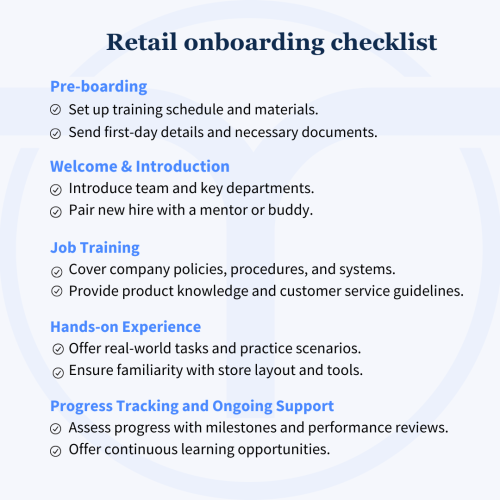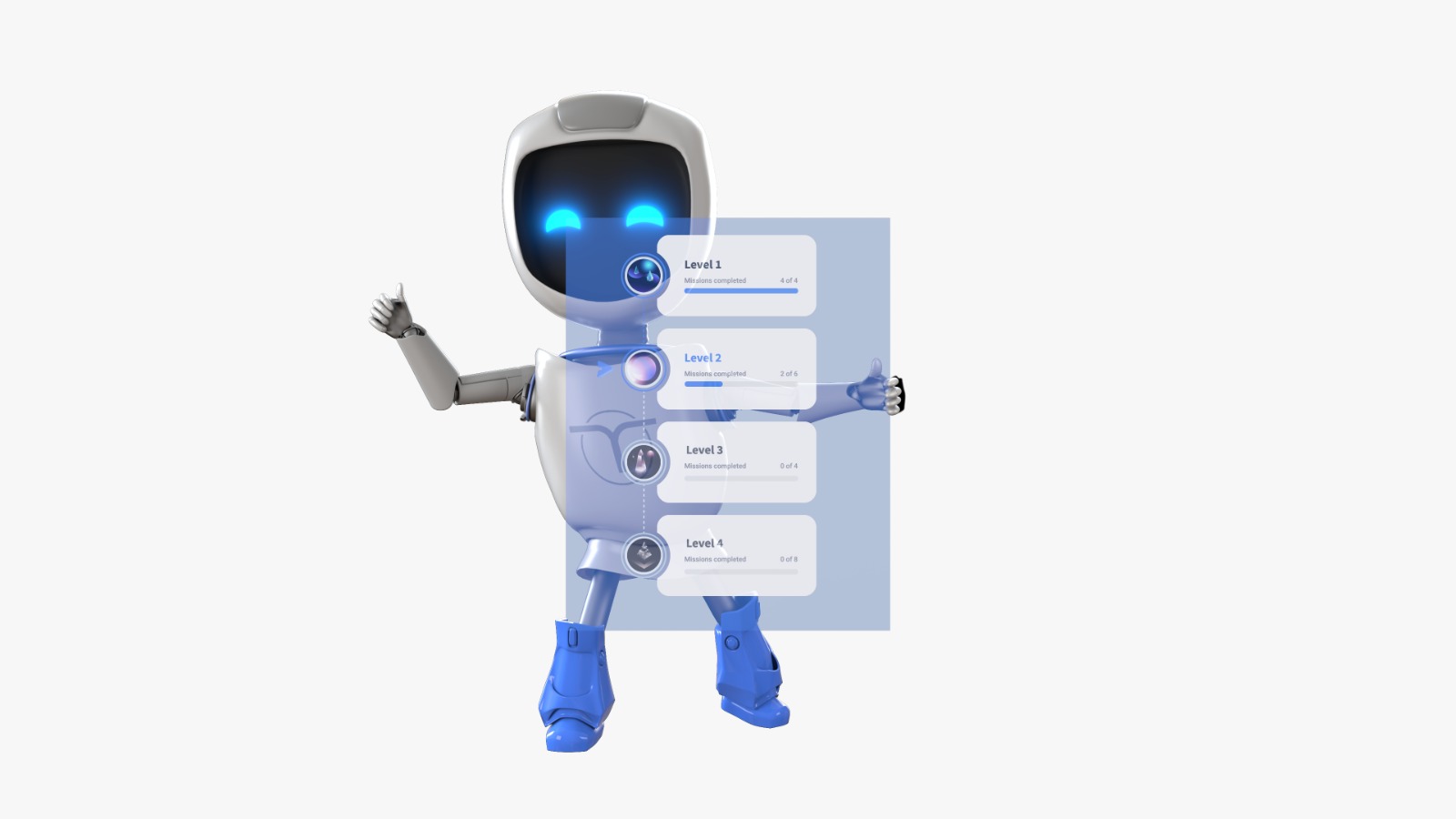Sticking to a retail onboarding checklist has been the standard of training new employees for years, but data shows they’re not as efficient as expected. According to McKinsey, employee turnover in frontline retail has been at least 60% for years, making it one of the highest turnover industries in the U.S., alongside hospitality.
With up to 20% of employees leaving within their first 45 days and employers investing the equivalent of six to nine months of a worker’s salary to replace them, it’s clear that retail must rethink its approach to onboarding.
The problem isn’t what’s in a retail onboarding checklist but how it’s delivered. To keep up with market demands and employee expectations, companies must integrate technology into their onboarding process. AI, learning management systems (LMS), virtual reality (VR), and e-learning platforms are just some of the tools transforming training today. But in this article, we’ll focus on one particularly effective approach: microlearning.
The Problem with Outdated Retail Onboarding Checklists
A strong onboarding process leads to greater productivity and retention, with 54% of companies experiencing higher productivity and 50% seeing better retention. However, this data only applies when the organization commits to providing the best induction experience for their new employees. Unfortunately, only 12% of employees strongly agree that their organization does onboarding well.
A survey on onboarding’s impact on employee success found that traditional methods can be overwhelming. New hires are bombarded with excessive information, forced to learn multiple software programs at once, and expected to remember it all. In the same survey, employees described onboarding as “too much all at once” and claimed information is “scattered across too many platforms” to keep up.
With such challenges, the need for a more engaging, structured, and accessible onboarding experience intensifies.
Common Struggles in Onboarding Retail Workers
According to Retail Dive, 32% of retail employees report receiving no formal training—the highest of any industry—leaving many unprepared for the demands of the job. Retail workers face unique challenges from day one, making structured training essential for retention. Here are some of the biggest struggles employees encounter during onboarding:
High turnover: Many retail employees are college students or part-time workers who see their jobs as temporary stepping stones rather than long-term career opportunities. This creates a constant cycle of hiring and training, which drains resources.
Immediate productivity expectations: High turnover leads to retail employers often expecting new hires to hit the ground running. However, this high-pressure environment can be overwhelming for employees who need time to understand their responsibilities and adapt to the new job.
High stress: The retail industry frequently involves customer interactions that can become tense, especially during peak hours or with difficult customers. For newcomers, this can be particularly stressful as they may lack experience in managing conflicts or misunderstandings.
Information overload: New hires are typically bombarded with an extensive amount of information, including company policies, systems, and procedures. Employees struggle to retain and apply so much information all at once, making it hard to focus on doing their job.
Frequent mistakes: It’s a rule of thumb that new employees are prone to making mistakes in the beginning. These errors can lead to frustration and a lack of confidence, as employees may feel that they are not receiving enough guidance to succeed in their roles.
Microlearning: An Effective Onboarding Tool
Microlearning refers to the practice of delivering training content in small, digestible chunks, usually in the form of videos, quizzes, or interactive content. It’s designed to improve knowledge retention and engagement by breaking down complex information into easy-to-understand pieces.
Shorter Content, Better Information Retention
In a survey, 17% of respondents report they remember less than half of their training immediately after completing it. Thirty days after completing training, that number jumps to 32%, mostly because of the forgetting curve, which states that people forget 80% of what they learned after only one month.
Microlearning platforms combat this by delivering content into small, easy-to-remember chunks that employees can review anytime, helping them remember more.
For retail: Sections of training content can be presented like a quest or series of missions, where employees learn about procedures, software, and protocols in small steps. This way, retail workers aren’t rushed and can absorb information at their own pace, which improves long-term retention and confidence in their roles.
AI-Driven Customization
Cohort-based learning paths, which are also enhanced by AI, are tailored to group needs, fostering peer-to-peer learning and collaboration while aligning content with employees’ roles and performance. Employees receive the most relevant training and can move at their own pace, without overwhelming them.
For retail: AI helps break down heavy-handed information from training documents like company policies, procedures, and product information into interactive microlearning modules. 200-pages documents easily turn into a string of 7-minutes missions, easier to manage and understand. Additionally, training supervisors can generate and edit missions as needed, allowing for more flexibility and time-saving.
Accessibility via Mobile
A report revealed that almost half (47%) of retail staff wanted training to be delivered digitally, while almost three-quarters (74%) said they would welcome mobile training. Mobile accessibility allows employees to access training materials anytime and anywhere, making it easy for them to learn on the go.
For retail: Retail employees can quickly access training on mobile devices, whether they’re on the sales floor or during breaks. This is especially important for workers who may not have easy access to a computer during their shifts or for those who may not have set hours or work in various locations during onboarding.
Real-World Application
According to a study, 79% of employees prefer to learn while doing. Providing real-world scenarios in training helps employees apply what they’ve learned in a practical way. This includes simulations, role-playing, or situational exercises that mimic real job tasks. It also helps build confidence, as they can practice skills in a controlled environment before using them in real situations.
For retail: Retail employees can be given a mission to arrange produce or products according to company guidelines and take a photo to submit as proof. This ensures they understand how to apply procedures correctly, per company standards.
Collaboration
Microlearning platforms incorporate collaborative elements, where employees work together to solve problems or complete training missions. Collaborative learning fosters communication and allows employees to learn from one another, creating a sense of community and teamwork.
For retail: Missions can include multiple team members, simulating real-life scenarios where employees have to collaborate to complete tasks, such as stocking shelves or preparing displays.
Gamification
Gamification involves turning training into a game, where employees can earn rewards, complete challenges, and compete with colleagues. This feature makes training engaging and entertaining even for young workers.
For retail: Challenges like achieving certain sales goals, completing product knowledge quizzes, or improving customer service scores turns training into friendly competition. For example, employees could “level up” by mastering different parts of their job, such as checkout procedures or inventory management.
Improve Your Retail Onboarding Checklist with Microlearning
Here’s a comprehensive list of steps for a successful retail onboarding experience using the power of microlearning.
Step 1: Pre-boarding
A few days before a new employee starts, the training supervisor should set up the entire onboarding process on the microlearning platform. They should generate the missions based on the company’s procedures, edit them as needed, and send invitation links through the employee’s work email. Meanwhile, HR reps should send important details about the first day and any other relevant information to the employee’s personal email.
This helps employees feel connected to the company before they even step into the store and gives them the opportunity to ask questions and mentally prepare for their first day.
Step 2: Welcome and Introduction
The first day can be intimidating, so it’s important to make new hires feel comfortable. Introduce them to their team through engaging, short-form videos and interactive modules. Pairing them with a mentor or buddy can also help ease first-day nerves and provide guidance.
Additionally, use this opportunity to help new hires familiarize themselves with the store, its departments, key areas, and people through targeted missions. Microlearning shines here with missions such as story and experience sharing, making it easy for new employees to connect with their environment and team in a fun and interactive way.
Step 3: Job Training and Product Knowledge
After introductions comes the educational part of training. From company procedures and system and software training to product knowledge and customer service skills, this part of the training often poses the most challenges in terms of engagement and attention retention. Instead of overwhelming new hires with thick manuals, break the information into digestible lessons on microlearning platforms, such as:
- Short, Focused Videos: Teach key procedures and policies in quick, engaging videos that can be viewed anytime.
- Interactive Quizzes: Reinforce product knowledge and customer service skills through quizzes that provide instant feedback.
- Scenario-Based Learning: Use real-world scenarios to help employees apply what they’ve learned, such as handling customer inquiries or navigating store procedures.
- Step-by-Step Guides: Offer visual aids and step-by-step instructions for complex tasks, ensuring employees can easily follow along.
Step 4: Ongoing Support and Setting Expectations
The onboarding process shouldn’t stop after the first week or even month. It’s essential to continue offering support to the new employee until they gain enough experience to be on their own.
Here’s how to maintain momentum and keep them on track:
- Regular Check-Ins: Schedule consistent one-on-one meetings to assess progress, provide feedback, and address any concerns.
- Reinforcement Training through Microlearning Updates: Offer targeted lessons regularly to reinforce key concepts.
- Peer Learning Opportunities: Pair new hires with experienced colleagues for peer mentoring and knowledge sharing.
- Tracking Progress with Milestone-Based Assessments: Use microlearning tools to track employee progress through milestone-based assessments.
- Real-Time Feedback: Provide immediate feedback after completing training modules to reinforce learning and correct mistakes.

The Future of Retail Onboarding
A modern retail onboarding checklist isn’t just a formality—it’s a strategy to keep employees engaged, productive, and loyal. By replacing outdated methods with microlearning and digital tools, retailers can reduce turnover and create a better workplace.
Platforms like Code of Talent revolutionize retail onboarding by delivering microlearning-based training and features such as:
- AI-powered personalization
- Engaging, interactive learning
- Mobile-first access
- Real-time feedback
- Collaboration tools
Embracing platforms like Code of Talent ensures onboarding isn’t just a one-time event but an ongoing journey, setting employees up for long-term success. Update your retail onboarding checklist and revolutionize the way you train your new employees now!
Cover photo: Freepik





